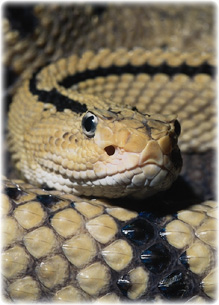Difference between revisions of "Snake Skin"
| Line 1: | Line 1: | ||
{{unfinished}} | {{unfinished}} | ||
| − | Reptile skin functions to protect from physical trauma, desiccation, infection, osmotic damage and extremes of temperature. There are several layers. The dermis is mainly connective tissue but contains the pigment cells. The epidermis is characterised by scales that are covered with keratin. The size and shape of scales varies greatly among species, for example the bushmaster has scales that are large with a dermal core or osteoderm while they may be partially overlapping and keeled in the rattlesnake. The smallest scales are seen in the boids and worm snakes. The ventral scales (or scutes) are generally larger and thicker than the lateral and dorsal scales. | + | [[Image:718035.jpg|300px|thumb|right|©RVC and its licensors, Peer Zwart and Fredric Frye. All rights reserved.]] |
| + | Reptile skin functions to protect from physical trauma, desiccation, infection, osmotic damage and extremes of temperature. There are several layers. The dermis is mainly connective tissue but contains the pigment cells. The epidermis is characterised by scales that are covered with keratin. The size and shape of scales varies greatly among [[:Category:Snake Species|species]], for example the bushmaster has scales that are large with a dermal core or osteoderm while they may be partially overlapping and keeled in the rattlesnake. The smallest scales are seen in the [[Boidae|boids]] and worm snakes. The ventral scales (or scutes) are generally larger and thicker than the lateral and dorsal scales. | ||
| − | + | The skin of reptiles has numerous functions including display, protection, camouflage, [[Thermoregulation|thermoregulation]] and fluid homeostasis. | |
| − | * The | + | The skin is dry, with few glands compared with mammals and amphibians. |
| + | |||
| + | ==Epidermis== | ||
| + | |||
| + | The epidermis consists of 3 layers: | ||
| + | * ''Stratum germinatum'' - which divides and produces keratin | ||
| + | * ''Stratum intermedium'' - which contains lipid, thus preventing fluid loss | ||
| + | * ''Stratum corneum'' - which forms scales and scutes | ||
| + | |||
| + | In reptiles, 2 forms of keratin are present: | ||
| + | * '''Alpha-keratin''' which is flexible and often found between scales and scutes and in hinges. | ||
| + | * '''Beta-keratin''' which is unique to reptiles. It is harder than alpha-keratin and forms scutes and scales. | ||
| + | |||
| + | ==Dermis== | ||
| + | The dermis of reptiles contains pigment cells, [[Snake Neurological System|nerves]] and vessels, although thick, keratinised skin is without cutaneous sensation, leaving captive reptiles at risk of [[Snake Vesicular Dermatitis|thermal burns]]. | ||
| + | |||
| + | ==Skin adaptations and cutaneous appendages== | ||
| + | *[[Snake Eye|'''Spectacles''']] - are clear scales over the eyes of snakes. | ||
| + | *'''Heat sensory pits''' (infrared-sensitive receptors) - are deep grooves between the nares and the eye of pit vipers, pythons and some [[Boidae|boas]] which allow them to 'see' the radiated heat of their prey. These pits can also be found on the upper lip, just below the nares, termed 'labial pits'. See [[Snake Special Senses|snake special senses]]. | ||
| + | *'''Rattle''' - present in some snakes and used to warn predators. It is enlarged with each shed. | ||
| + | *'''Gastropeges''' - are a single row of large ventral scales in snakes that aid [[Snake Locomotion|locomotion]]. | ||
[[Category:Snake_Anatomy]] | [[Category:Snake_Anatomy]] | ||
Revision as of 16:39, 24 April 2010
| This article is still under construction. |
Reptile skin functions to protect from physical trauma, desiccation, infection, osmotic damage and extremes of temperature. There are several layers. The dermis is mainly connective tissue but contains the pigment cells. The epidermis is characterised by scales that are covered with keratin. The size and shape of scales varies greatly among species, for example the bushmaster has scales that are large with a dermal core or osteoderm while they may be partially overlapping and keeled in the rattlesnake. The smallest scales are seen in the boids and worm snakes. The ventral scales (or scutes) are generally larger and thicker than the lateral and dorsal scales.
The skin of reptiles has numerous functions including display, protection, camouflage, thermoregulation and fluid homeostasis.
The skin is dry, with few glands compared with mammals and amphibians.
Epidermis
The epidermis consists of 3 layers:
- Stratum germinatum - which divides and produces keratin
- Stratum intermedium - which contains lipid, thus preventing fluid loss
- Stratum corneum - which forms scales and scutes
In reptiles, 2 forms of keratin are present:
- Alpha-keratin which is flexible and often found between scales and scutes and in hinges.
- Beta-keratin which is unique to reptiles. It is harder than alpha-keratin and forms scutes and scales.
Dermis
The dermis of reptiles contains pigment cells, nerves and vessels, although thick, keratinised skin is without cutaneous sensation, leaving captive reptiles at risk of thermal burns.
Skin adaptations and cutaneous appendages
- Spectacles - are clear scales over the eyes of snakes.
- Heat sensory pits (infrared-sensitive receptors) - are deep grooves between the nares and the eye of pit vipers, pythons and some boas which allow them to 'see' the radiated heat of their prey. These pits can also be found on the upper lip, just below the nares, termed 'labial pits'. See snake special senses.
- Rattle - present in some snakes and used to warn predators. It is enlarged with each shed.
- Gastropeges - are a single row of large ventral scales in snakes that aid locomotion.
